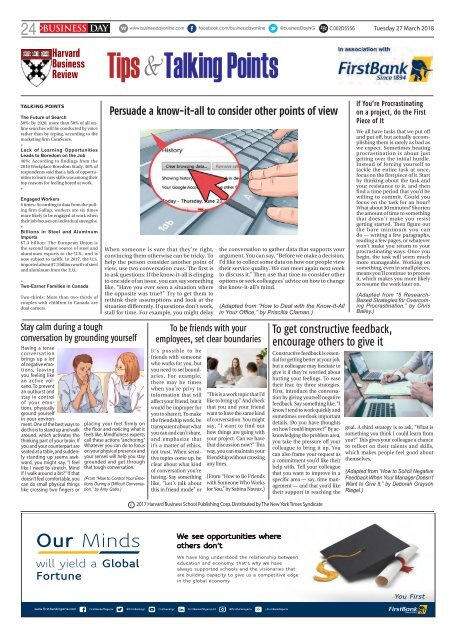BusinessDay 27 Mar 2018
Create successful ePaper yourself
Turn your PDF publications into a flip-book with our unique Google optimized e-Paper software.
24 BUSINESS DAY C002D5556 Tuesday <strong>27</strong> <strong>Mar</strong>ch <strong>2018</strong><br />
Harvard<br />
Business<br />
Review<br />
Tips<br />
&<br />
Talking Points<br />
TALKING POINTS<br />
The Future of Search<br />
50%: By 2020, more than 50% of all online<br />
searches will be conducted by voice<br />
rather than by typing, according to the<br />
marketing firm ComScore.<br />
+<br />
Lack of Learning Opportunities<br />
Leads to Boredom on the Job<br />
46%: According to findings from the<br />
2016 Workplace Boredom Study, 46% of<br />
respondents said that a lack of opportunities<br />
to learn new skills was among their<br />
top reasons for feeling bored at work.<br />
+<br />
Engaged Workers<br />
6 times: According to data from the polling<br />
firm Gallup, workers are six times<br />
more likely to be engaged at work when<br />
their job focuses on individual strengths.<br />
+<br />
Billions in Steel and Aluminum<br />
Imports<br />
$7.3 billion: The European Union is<br />
the second largest source of steel and<br />
aluminum exports to the U.S., and is<br />
now subject to tariffs. In 2017, the U.S.<br />
imported about $7.3 billion worth of steel<br />
and aluminum from the E.U.<br />
+<br />
Two-Earner Families in Canada<br />
Two-thirds: More than two-thirds of<br />
couples with children in Canada are<br />
dual earners.<br />
Stay calm during a tough<br />
conversation by grounding yourself<br />
Having a tense<br />
conversation<br />
brings up a lot<br />
of negative emotions,<br />
leaving<br />
you feeling like<br />
an active volcano.<br />
To prevent<br />
an outburst and<br />
stay in control<br />
of your emotions,<br />
physically<br />
ground yourself<br />
in your environment.<br />
One of the best ways to<br />
do this is to stand up and walk<br />
around, which activates the<br />
thinking part of your brain. If<br />
you and your counterpart are<br />
seated at a table, and suddenly<br />
standing up seems awkward,<br />
you might say, “I feel<br />
like I need to stretch. Mind<br />
if I walk around a bit?” If that<br />
doesn’t feel comfortable, you<br />
can do small physical things<br />
like crossing two fingers or<br />
Persuade a know-it-all to consider other points of view<br />
When someone is sure that they’re right,<br />
convincing them otherwise can be tricky. To<br />
help the person consider another point of<br />
view, use two conversation cues. The first is<br />
to ask questions: If the know-it-all is clinging<br />
to one side of an issue, you can say something<br />
like, “Have you ever seen a situation where<br />
the opposite was true?” Try to get them to<br />
rethink their assumptions and look at the<br />
situation differently. If questions don’t work,<br />
stall for time. For example, you might delay<br />
placing your feet firmly on<br />
the floor and noticing what it<br />
feels like. Mindfulness experts<br />
call these actions “anchoring.”<br />
Whatever you can do to focus<br />
on your physical presence and<br />
your senses will help you stay<br />
grounded and get through<br />
that tough conversation.<br />
(From “How to Control Your Emotions<br />
During a Difficult Conversation,”<br />
by Amy Gallo.)<br />
To be friends with your<br />
employees, set clear boundaries<br />
It’s possible to be<br />
friends with someone<br />
who works for you, but<br />
you need to set boundaries.<br />
For example,<br />
there may be times<br />
when you’re privy to<br />
information that will<br />
affect your friend, but it<br />
would be improper for<br />
you to share it. To make<br />
the friendship work, be<br />
transparent about what<br />
you can and can’t share,<br />
and emphasize that<br />
it’s a matter of ethics,<br />
not trust. When sensitive<br />
topics come up, be<br />
clear about what kind<br />
of conversation you’re<br />
having. Say something<br />
like, “Let’s talk about<br />
this in friend mode” or<br />
the conversation to gather data that supports your<br />
argument. You can say, “Before we make a decision,<br />
I’d like to collect some data on how our people view<br />
their service quality. We can meet again next week<br />
to discuss it.” Then use that time to consider other<br />
options or seek colleagues’ advice on how to change<br />
the know-it-all’s mind.<br />
(Adapted from “How to Deal with the Know-It-All<br />
in Your Office,” by Priscilla Claman.)<br />
“This is a work topic that I’d<br />
like to bring up.” And check<br />
that you and your friend<br />
want to have the same kind<br />
of conversation. You might<br />
say, “I want to find out<br />
how things are going with<br />
your project. Can we have<br />
that discussion now?” This<br />
way, you can maintain your<br />
friendship without crossing<br />
any lines.<br />
(From “How to Be Friends<br />
with Someone Who Works<br />
for You,” by Sabina Nawaz.)<br />
If You’re Procrastinating<br />
on a project, do the First<br />
Piece of It<br />
We all have tasks that we put off<br />
and put off, but actually accomplishing<br />
them is rarely as bad as<br />
we expect. Sometimes beating<br />
procrastination is about just<br />
getting over the initial hurdle.<br />
Instead of forcing yourself to<br />
tackle the entire task at once,<br />
focus on the first piece of it. Start<br />
by thinking about the task and<br />
your resistance to it, and then<br />
find a time period that you’d be<br />
willing to commit. Could you<br />
focus on the task for an hour?<br />
What about 30 minutes? Shorten<br />
the amount of time to something<br />
that doesn’t make you resist<br />
getting started. Then figure out<br />
the bare minimum you can<br />
do — writing a few paragraphs,<br />
reading a few pages, or whatever<br />
won’t make you return to your<br />
procrastinating ways. Once you<br />
begin, the task will seem much<br />
more manageable. Working on<br />
something, even in small pieces,<br />
means you’ll continue to process<br />
it, which makes you more likely<br />
to resume the work later on.<br />
(Adapted from “5 Research-<br />
Based Strategies for Overcoming<br />
Procrastination,” by Chris<br />
Bailey.)<br />
To get constructive feedback,<br />
encourage others to give it<br />
Constructive feedback is essential<br />
for getting better at your job,<br />
but a colleague may hesitate to<br />
give it if they’re worried about<br />
hurting your feelings. To ease<br />
their fear, try three strategies.<br />
First, introduce the conversation<br />
by giving yourself negative<br />
feedback. Say something like, “I<br />
know I tend to work quickly and<br />
sometimes overlook important<br />
details. Do you have thoughts<br />
on how I could improve?” By acknowledging<br />
the problem area,<br />
you take the pressure off your<br />
colleague to bring it up. You<br />
can also frame your request as<br />
a commitment you’d like their<br />
help with. Tell your colleague<br />
that you want to improve in a<br />
specific area — say, time management<br />
— and that you’d like<br />
their support in reaching the<br />
goal. A third strategy is to ask, “What is<br />
something you think I could learn from<br />
you?” This gives your colleague a chance<br />
to reflect on their talents and skills,<br />
which makes people feel good about<br />
themselves.<br />
(Adapted from “How to Solicit Negative<br />
Feedback When Your Manager Doesn’t<br />
Want to Give It,” by Deborah Grayson<br />
Riegel.)<br />
c<br />
2017 Harvard Business School Publishing Corp. Distributed by The New York Times Syndicate


















